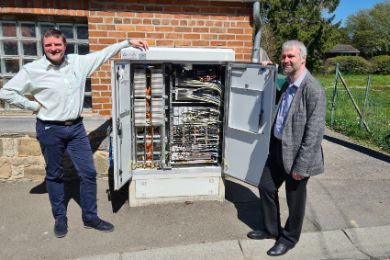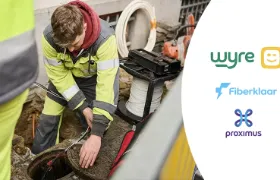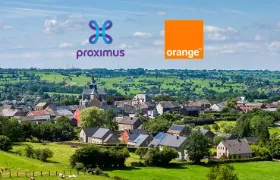Twice the speed and capacity of the current VDSL broadband network? A leap forward made possible by a world first launched by Proximus and Nokia in Andenne
The lockdown of recent months has demonstrated the importance of having a reliable Internet connection, whether for teleworking, remote learning or streaming movies, for example. More than ever, broadband has become a real necessity. To meet this growing need for connectivity, Proximus is gradually rolling out fiber, with the aim of covering 70% of households in Belgium by 2028. In addition, Proximus is also improving its existing VDSL infrastructure. Nokia and Proximus engineers have teamed up to develop 2MX6 technology, which allows the servicing of twice as many customers in a single street cabinet, while doubling the speed of broadband Internet and reducing energy consumption. This innovation has just been deployed in real conditions for the first time in the world in Andenne. In the coming months, it will be rolled out in hundreds of additional street cabinets.
It doesn’t happen every day for Belgium to host a technological world first. And yet, that is what has just happened in Andenne. It was in this Walloon city that Proximus and Nokia carried out the unprecedented installation of a new piece of equipment that will seriously boost all copper networks in the world in the years to come. Proximus and Nokia engineers, who have been working together on technological innovation projects for more than 20 years, have joined forces to develop equipment that boosts both the speed and capacity of the ROPs (Remote Optical Platforms), i.e. the street cabinets in which the copper cables coming from consumers' homes are connected to the Proximus network via fiber.
In concrete terms, with a moderate investment, the new Nokia equipment makes it possible to double the maximum potential number of customers connected to a street cabinet, from 192 to 384 users per ROP. It also paves the way for a significant increase in the speed of VDSL connectivity, enabling ultra-fast broadband to be delivered at twice the speed. This will allow an enhanced experience for more customers, even outside major cities. Moreover, these improvements can be achieved without the slightest inconvenience to the neighborhood: miniaturization of electronics makes it possible to insert this high-performance equipment into existing street cabinets without the need to install a new cabinet, thus making it possible to accommodate more customers without any street works.
More speed, more capacity and less power consumption
This new technology, which is based on the Quillion chip developed by Nokia, has another major advantage. While enabling higher speed and capacity, the Quillion chip also reduces power consumption. This is particularly important for Proximus, one of whose key priorities is the reduction of its ecological footprint.
Andenne is therefore the very first location in the world to benefit from this technological innovation, also referred to as "ultra-dense vectorization". The engineers at Proximus and Nokia do not intend to leave it at that. The goal is to insert the same equipment in hundreds of street cabinets in the coming months and years. This is obviously good news for Proximus customers, but also for the customers of all alternative operators who use the Proximus network. Their customers will also benefit from the improved VDSL ultravectoring connectivity.
Patrick DelcoigneDirector Network Engineering & Operations at ProximusOur absolute priority is the fiber roll-out, which is at the heart of our strategy, to achieve 70% Fiber-To-The-Home coverage of the population by 2028. In the first quarter of this year alone, Proximus rolled out fiber to an additional 73,000 buildings, extending its fiber coverage to 533,000 households and businesses. At the same time, it is important to us that consumers who do not have direct access to fiber can also benefit from high-speed Internet. This highlights the importance of this technology, developed with Nokia and rolled out for the first time in Andenne. It is the densest and fastest copper solution that can be inserted into a street cabinet. With this new solution, we are able to bring more bandwidth to more people.
Geert HeyninckGeneral Manager Broadband Access Business Unit at NokiaProximus and Nokia have been developing joint innovations for 20 years to get the most out of copper networks in combination with fiber. We have already raised the bar in recent years with VDSL and then with vectoring, but now we are going one step further with this new equipment for street cabinets. Thanks to our close cooperation, we were able to design this unique solution, which doubles the speed and accommodates twice as many customers in a single street cabinet. This makes the need for a second street cabinet obsolete forever.




